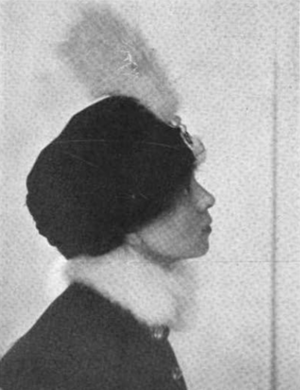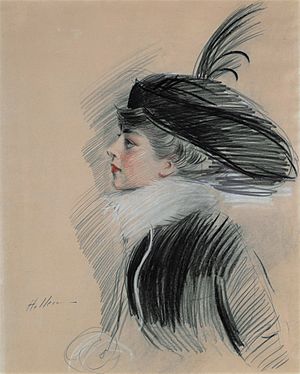Belle da Costa Greene facts for kids
Quick facts for kids
Belle da Costa Greene
|
|
|---|---|

Belle da Costa Greene (1914)
|
|
| Born |
Belle Marion Greener
November 26, 1879 Washington, D.C., US
|
| Died | May 10, 1950 (aged 70) New York City, US
|
| Occupation | Librarian |
| Employer | J. P. Morgan, Princeton University |
| Parent(s) |
|

Belle da Costa Greene (born November 26, 1879 – died May 10, 1950) was an amazing American librarian. She is famous for managing and building the huge personal library of J. P. Morgan, a very rich financier.
After Morgan passed away in 1913, Belle continued her work for his son, Jack Morgan. In 1924, she became the first director of the Pierpont Morgan Library. This was a big deal, especially for a woman at that time. Even though her parents were Black, Belle lived her professional life as a white person. This was a way to overcome the racial barriers of her time.
Contents
Belle da Costa Greene: Her Early Life
Belle da Costa Greene was born in Washington, D.C.. Her birth name was Belle Marion Greener. She was born on November 26, 1879.
Her mother, Genevieve Ida Fleet, was a music teacher. She came from a well-known African-American family in Washington, D.C. Belle's father, Richard Theodore Greener, was a very important person. He was the first Black student to graduate from Harvard. He became a lawyer, professor, and worked for racial justice. He even served as a dean at Howard University School of Law.
After her parents separated, Belle, her mother, and her siblings changed their last name to Greene. They also started living as white people. This was a way to protect themselves and get more opportunities in a society that had many racial barriers. Belle also changed her middle name to 'da Costa'. She sometimes said she had a Portuguese background. This helped explain her darker skin.
Belle da Costa Greene: Her Career as a Librarian
Belle Greene started her library career at the Princeton University Library in 1902. There, she learned how to organize books and help people find information. She also became very knowledgeable about rare books.
While working at Princeton, she met Junius Spencer Morgan II. He later introduced her to his uncle, the famous financier J.P. Morgan. In 1905, Belle began working as J.P. Morgan's personal librarian.
Building a World-Class Collection
Belle's first job was to organize and catalog Morgan's huge collection of books. She worked with an experienced assistant, Ada Thurston. By 1908, Belle was traveling the world for Morgan. She was trusted for her amazing knowledge, especially about old handwritten books called illuminated manuscripts. She was also a skilled negotiator.
Belle spent millions of dollars buying and selling rare manuscripts, books, and art for Morgan. She wanted his library to be the best. She focused on getting important items like incunabula (very early printed books), manuscripts, and beautiful book bindings.
In 1912, The New York Times praised her "force of persuasion and intelligence." They wrote about how she bought seventeen rare books by William Caxton for the Morgan library before an auction. Belle believed that rare books should be available for everyone to see, not just kept by private collectors.
Making the Library Public
After J.P. Morgan died in 1913, Belle continued working for his son, J.P. Morgan Jr.. Morgan left her a large sum of money in his will. She also earned a very high salary for a woman at that time.
In 1924, the Morgan Library became a public institution. Belle da Costa Greene was named its first director. She celebrated by setting up many exhibitions. One exhibition attracted a record 170,000 visitors! This showed her dedication to sharing these treasures with the public. She retired from her position in 1948. When she passed away in 1950, The New York Times called her "one of the best known librarians in the country."
In 1949, the Morgan Library held an exhibition of over 250 of the best items Belle had bought. She attended the event in a wheelchair.
Other Professional Roles
Beyond her work at the Morgan Library, Belle Greene held other important roles. She was one of the first women to be named a fellow of the Mediaeval Academy of America. She was also a fellow with the Metropolitan Museum of Art. Belle also served on the editorial boards for art magazines like Gazette des Beaux Art and ARTnews.
Belle da Costa Greene: Her Personal Life
Belle Greene never married. Her mother, Genevieve, lived with her for many years. Belle also played an active role in raising her nephew, Robert Mackenzie Leveridge.
Belle Greene passed away on May 10, 1950, in New York City. Before her death, she destroyed many of her personal papers. However, some records and letters she wrote are still kept by others. Her professional letters are also saved at The Morgan Library & Museum.
Popular Culture
The 2021 book The Personal Librarian tells a historical fiction story about Belle Greene's life. It covers her personal and professional journey as J.P. Morgan's librarian.
See also
 In Spanish: Belle da Costa Greene para niños
In Spanish: Belle da Costa Greene para niños

